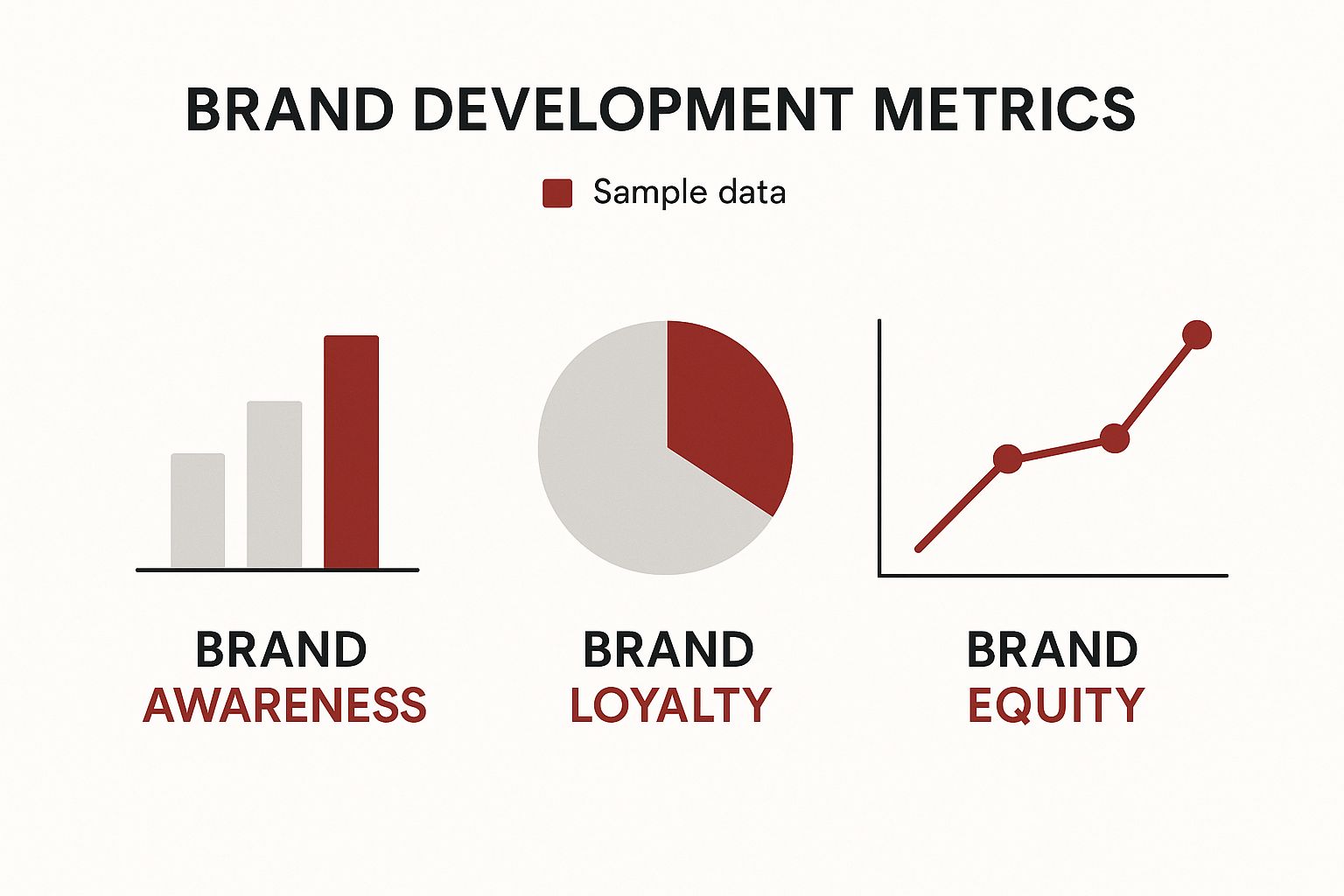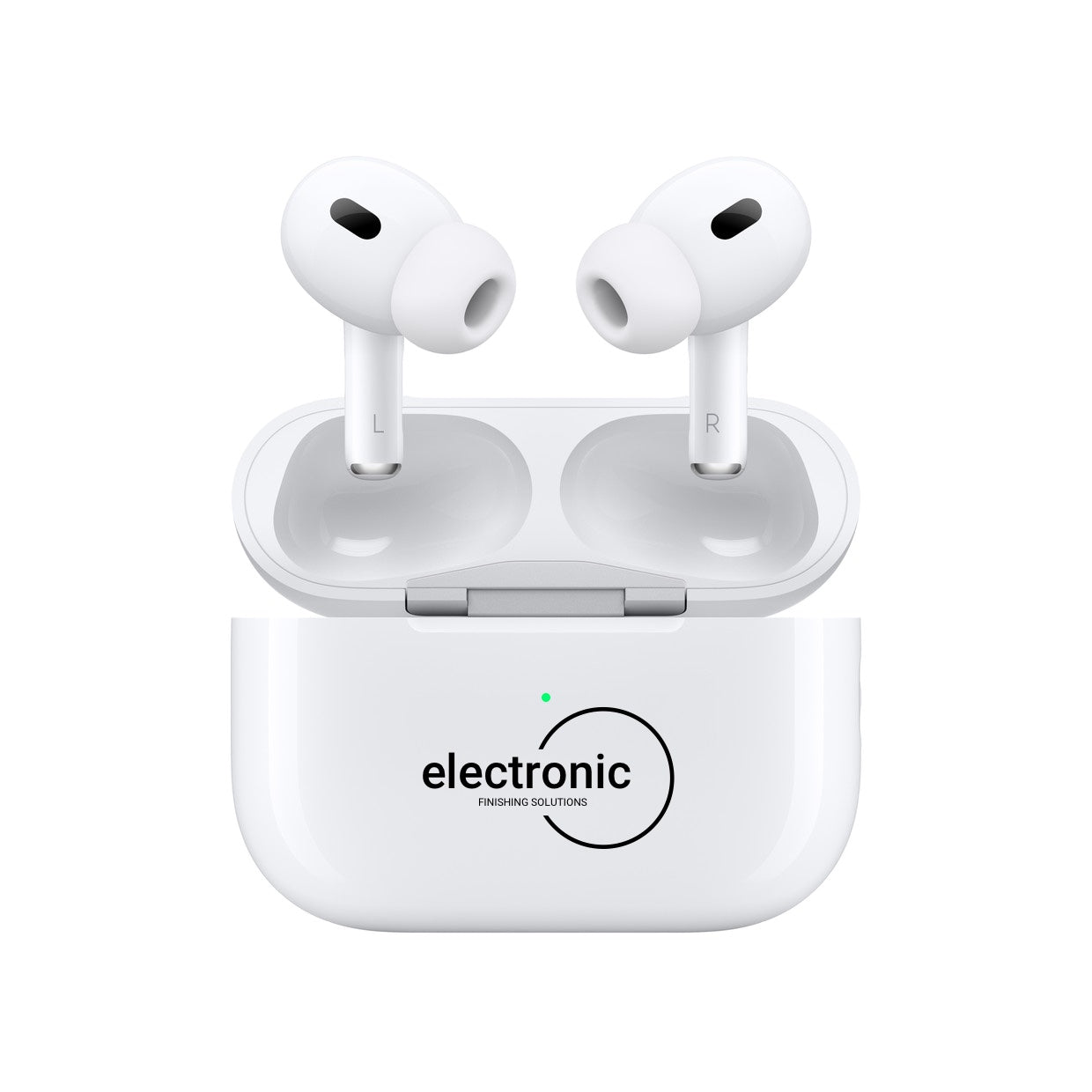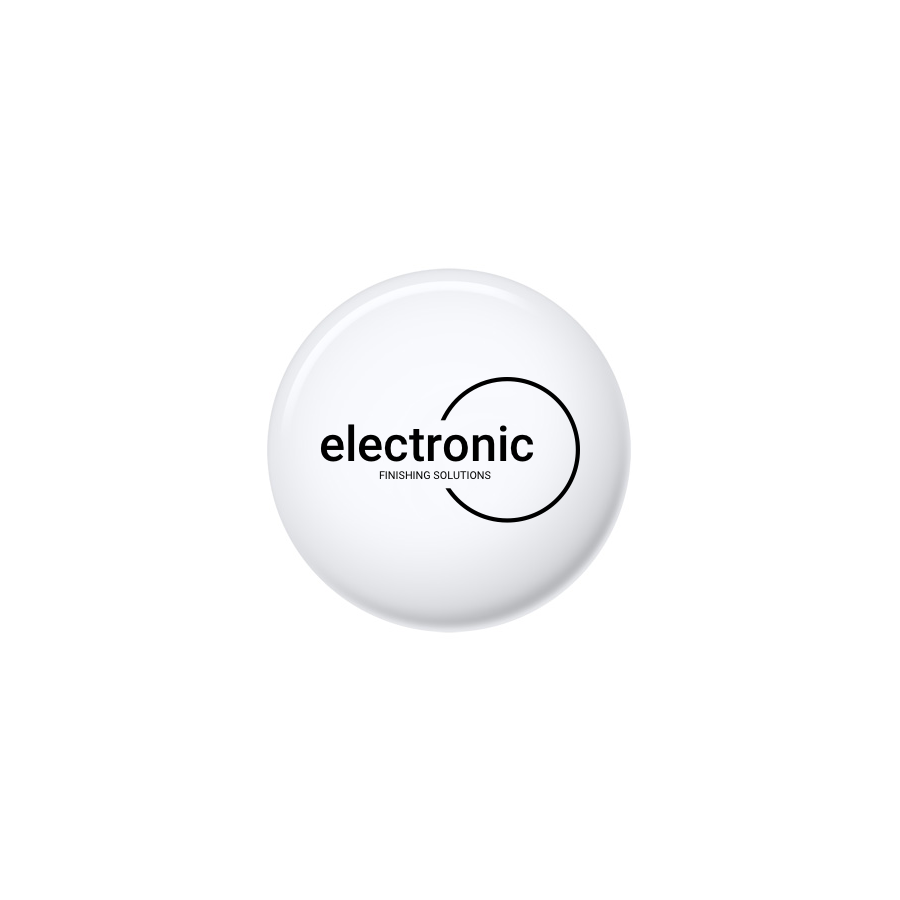Why Most Brand Development Strategies Fall Flat
Let's be honest: many brand strategies look great on paper but end up as expensive documents gathering digital dust in a shared drive. Companies pour resources into what they think is a solid brand development strategy, only to face the same old problems with visibility and customer connection months later. The issue isn't usually a lack of effort; it's a deep misunderstanding of what a brand strategy is really for. It's not just a marketing project—it's supposed to be a core business directive.
The strategy starts to fall apart when there's a wall between brand creation and day-to-day business operations. A strategy fails when it’s seen as a cosmetic fix—a new logo, a catchy tagline—instead of the central idea that guides the entire company. When the brand’s promise doesn't match the actual customer experience, sales process, or product quality, customers feel that disconnect right away. This gap is the main reason so many branding efforts don't produce real results.
The Disconnect Between Perception and Reality
Another common trap is chasing trends instead of building something authentic and lasting. A brand development strategy built on passing fads or generic claims like "quality and service" is set up to fail from the start. Today, those are just the price of entry, not what makes you different. Successful brands find a unique, ownable spot in the market that genuinely connects with a specific audience. They don't try to be everything to everyone.
For example, a promotional electronics company like ours doesn’t just sell custom gadgets; we provide a seamless, high-touch gifting experience that makes our clients look great. That’s a strategic position, not just a description of what we do.
To better understand how a modern strategic approach differs from older, more tactical methods, let's compare them side-by-side.
| Element | Traditional Approach | Modern Strategic Approach | Business Impact |
|---|---|---|---|
| Focus | Logo, tagline, and visual assets (cosmetic). | Core purpose, values, and customer experience. | Builds a resilient business, not just a pretty face. |
| Audience | Tries to appeal to a broad, general market. | Targets a specific, well-defined niche audience. | Higher conversion rates and stronger customer loyalty. |
| Process | An isolated project led by the marketing team. | An integrated business function involving all departments. | Ensures brand consistency across every customer touchpoint. |
| Messaging | Based on generic claims like "quality" or "service." | Built on a unique value proposition that is ownable. | Creates a clear and memorable market differentiator. |
| Measurement | Tracks surface-level metrics like brand awareness. | Measures deep engagement, loyalty, and brand equity. | Delivers measurable, long-term financial returns. |
This comparison shows that a modern strategy is deeply woven into the fabric of the business. It’s a shift from just looking different to being different in a way that truly matters to your customers.
Valuing the Brand as a Core Asset
The most successful companies know that their brand is one of their most valuable assets. The economic power of a strong brand is clear, even when the wider economy is sluggish. For example, projections show the total value of the world's top 500 brands will be close to $9.5 trillion in 2025, a major increase from 2024. You can learn more about this in the latest Brand Finance Global 500 preview.
This growth happens even as the global economy faces challenges, proving that companies investing in strong brand development build resilient, long-term value that isn't tied to market whims.

The infographic above shows that a solid brand must build not just awareness, but also loyalty and long-term equity. Seeing tech and retail giants dominate market rankings confirms that brand strength directly leads to market leadership and financial success. In the end, a winning brand development strategy isn't about appearing different; it's about being different in a way that guides every decision your business makes.
Research Methods That Reveal What Customers Actually Want
To build a brand that truly connects, you have to get past what customers say they want. Traditional methods like focus groups can be tricky; people often tell you what they think you want to hear, or sometimes, they aren't even consciously aware of what really drives their decisions. A solid brand development strategy is built by digging deeper to find the emotional triggers and unspoken needs that actually influence purchasing.
It’s all about understanding the "why" behind the "what." Let's say you're a company that provides high-end promotional electronics. A quick survey might tell you that clients want "quality products." That’s not really an insight—it’s just a basic expectation. Deeper research, however, might reveal that a marketing manager's true motivation is the fear of looking cheap in front of their CEO if a corporate gift falls flat. Now that is a real emotional driver you can build a message around.
Moving Beyond Simple Surveys
Surveys still have their place, but their true value lies in how you design and interpret them. Instead of asking generic questions, focus on scenarios and past behaviors. For example, rather than asking, "What do you look for in a corporate gift?" try a more open-ended question like, "Describe the best corporate gift you ever received and what made it so memorable." This approach shifts the focus from generic features to genuine feelings and experiences. The goal is to collect stories, not just isolated data points.
To truly understand what customers want next, you can incorporate more advanced research methods. Using predictive analytics for marketing, for instance, can give you foresight into consumer behavior and preferences. These techniques help spot patterns and forecast future trends, giving your brand a strategic advantage.
Here's an example of how a market research platform might structure its services to uncover these deeper insights.
This shows a shift toward solutions that analyze the entire market, including trends and competitors, not just customer opinions. The takeaway is that modern research combines multiple data sources to paint a complete picture, which is vital for building a resilient brand strategy.
Practical Research Techniques for Deeper Insights
To get to the heart of what your customers desire, you need a mix of methods that observe actual behavior and uncover subconscious feelings. Here are a few practical approaches that deliver powerful results:
- Observational Research: Simply watch how people interact with products in their natural settings. For a company selling tech gifts, this could mean observing how people unbox and set up new gadgets. Do they struggle with the instructions? Do they immediately show the product off to others? These unprompted actions are pure gold.
- One-on-One Depth Interviews: Unlike focus groups where groupthink can influence answers, individual interviews let you dig much deeper. You can ask follow-up questions and explore emotional responses without the pressure of an audience. A key finding from a brand equity study showed that positive brand equity often comes from a deep personal connection, which is best uncovered in a one-on-one conversation.
- Competitive Intelligence Analysis: Don't just look at what your competitors do; analyze how their customers feel about them. Dive into review sites, social media comments, and forums. Are customers complaining about slow shipping? Are they raving about the unboxing experience? These are the gaps and opportunities your brand can jump on.
By combining these methods, you graduate from just gathering opinions to understanding genuine human behavior. This deep understanding is the bedrock of any brand development strategy that aims not just to be seen, but to be truly felt and remembered.
Positioning That Owns The Space That Matters Most

The screenshot above from Positioning.com shows just how timeless Jack Trout's original concept is, decades after he first introduced it. The main idea is still incredibly powerful: in a marketplace overflowing with options, your brand must claim a specific, valuable piece of your customer's mind.
Once your research has shown you what your customers really care about, the next part of your brand development strategy is to stake your claim on that territory. Great brand positioning isn't about finding a totally empty spot in the market. It's about finding the space that matters most to your ideal customer and then owning it so completely that your competition becomes an afterthought. Think of it like buying real estate—you don’t want just any plot of land; you want the one with the best view and a solid foundation for building something great.
This is the point where what you do best connects with what your audience wants most. For us, dealing in promotional electronics, we understand our clients aren't just ordering custom AirPods. They're buying reassurance. They're buying a memorable way to impress important stakeholders, a tool for building relationships, and the confidence that their brand will be presented with class. Our positioning, then, isn't about "custom tech." It's about delivering impeccable brand representation through premium corporate gifts. That's the real estate we own.
The Anatomy of a Powerful Positioning Statement
A sharp positioning statement acts as your company's internal North Star. While it’s not always a public-facing tagline, it’s a concise statement that guides every single decision. A strong statement clearly defines who you serve, what you provide for them, and what makes you different.
It should answer these key questions:
- For (Target Customer): Who is the specific group you’re trying to reach?
- Who seeks (Customer Need): What's the main problem or desire you address?
- Our Brand is a (Market Category): What business are you really in?
- That provides (Key Benefit): What is the single most attractive benefit you offer?
- Unlike (Primary Competitor): Who are you setting yourself apart from?
- Our brand offers (Unique Differentiator): What's your secret sauce?
For some hands-on inspiration, looking at different brand positioning statement examples can be a huge help. Seeing how other companies have boiled down their essence into a punchy sentence or two can really get the ideas flowing for your own.
Making Positioning a Company-Wide Mandate
Your positioning can't just be a poster in the marketing department; it needs to be lived and breathed by everyone in the company. Your sales team should use it to frame their conversations, your customer service team must reflect its promise, and your fulfillment team should understand how their work directly supports it. When every employee gets the brand’s position, they can deliver a consistent experience that reinforces it every step of the way. This consistency is what builds trust and, ultimately, deep loyalty.
This kind of internal alignment is more critical than ever. Customer loyalty is a pillar of any successful brand development strategy. Recent data shows that 80% of consumers globally define loyalty as buying from the same brand over and over. Furthermore, 70% feel a stronger bond with brands whose leaders openly communicate the brand’s purpose. There's a clear line connecting visible leadership, a strong purpose, and the repeat business that fuels growth. You can read more about the impact of purpose on brand loyalty. When your positioning is clear and genuine, it naturally becomes the purpose your whole team can get behind. To go deeper, you might find our guide to master effective brand positioning strategies today useful.
Crafting Messages That Connect And Drive Action
Once you've locked in your brand's position, it's time to give it a voice. This is where your brand development strategy moves from a concept on a whiteboard to messages that make people feel something and, more importantly, take action. This isn't just about dreaming up clever taglines; it's about creating a consistent messaging framework that communicates your value naturally and persuasively.
Where do many brands stumble? They either resort to vague statements like "We offer quality solutions" or get bogged down in features no one is asking for. Strong messaging makes your brand's promise crystal clear and emotionally compelling. For a company selling promotional electronics, saying "We sell custom AirPods" is true, but it's flat. A much better message is, "Give a gift they'll actually use, showcasing your brand every day." This connects the product to a deeper client desire: making a memorable impact.
Balancing Logic with Emotion
Every single purchase, whether it's a pack of gum or a thousand custom speakers, is a blend of logic and emotion. A solid brand development strategy finds the sweet spot between the two. The logical part of your message needs to clearly state the practical benefits. For instance, highlighting that our tech gifts come from top-tier brands like Apple and Bose ensures reliability and quality.
But the emotional hook is what really closes the deal. It speaks to the marketing manager's unspoken desire to look like a rockstar in front of their boss and clients. Your messaging should always answer the customer's silent question: "How will this make my job easier or my life better?"
- Rational Appeal: "Our all-inclusive pricing means no surprise fees, and orders ship within 10 business days."
- Emotional Appeal: "Experience the relief of a seamless gifting process, knowing every detail is handled perfectly."
By weaving these two appeals together, your message becomes both believable and desirable, creating a much stronger pull than logic or emotion could on its own.
Creating a Messaging Hierarchy
To keep your brand voice consistent, you need a messaging hierarchy. Think of it as a playbook that ensures every tweet, email, and sales pitch reinforces your core identity. A company that does this brilliantly is Mailchimp. They've built their entire brand around being the friendly, all-in-one marketing helper for small businesses.
Just look at how they structure their educational content to back this up.
Every article, from email marketing basics to audience growth hacks, reinforces their core mission: empowering small businesses. The genius here is that their content isn't random. It's a strategic part of their brand messaging, built to establish trust and show their expertise. By offering real help, they prove their brand promise instead of just talking about it.
This strategy builds positive brand equity because customers start to see the company as a helpful partner, not just another vendor. When your messaging strategy is on point, you consistently show that you understand and can solve your customer's biggest headaches, making your company the obvious choice.
Building Visual Systems That Strengthen Your Brand
Once you’ve nailed down your brand's position and messaging, it's time for the fun part: bringing it to life visually. A visual system is more than just a logo; it’s the complete visual language that speaks for your brand across every single customer interaction. A weak or inconsistent visual identity can undo even the most brilliant strategy, leaving customers confused. A strong one, however, builds instant recognition and reinforces your message without saying a word.
Think of your visual system like a person's personal style. It’s not about one specific outfit; it’s the way they consistently dress, their haircut, and even their body language. Together, these elements tell a story about who they are. Your brand’s visual system—from colors and fonts to photography style—needs to do the same. For a company offering premium promotional electronics, the visuals must communicate sophistication and reliability, not cheap and cheerful.
More Than Just a Pretty Picture
A strategic visual identity means making deliberate choices that reinforce your brand positioning. Every element should have a clear purpose. Why did you pick that specific shade of blue? What does that particular font say about your brand's personality? These decisions shouldn't be based on what just "looks good," but on what effectively communicates your core message.
This is especially critical when your brand is applied to physical products. Imagine receiving custom Bose headphones in a flimsy, poorly designed box. It instantly cheapens the product and the brand that sent it. The visual execution has to live up to the promise. For companies like ours, making sure the quality of the visual branding on a product is as high as the quality of the product itself is a top priority. Consistent, high-quality visuals are essential to improve brand visibility and stand out in a busy market.
You can see how different brands pull this off by looking at collections of identity projects on platforms like Behance. It showcases how visual elements combine to create a unified experience.

The takeaway from these examples is that strong brands don't just have one great logo. They have a flexible yet consistent system of colors, typography, and imagery that works everywhere, from a website to a custom-branded speaker.
Before we dive into the core components, let's break down how each visual element plays a strategic role in your brand's success. The following table maps out these connections.
| Visual Element | Strategic Function | Measurement Criteria | Common Mistakes |
|---|---|---|---|
| Logo | Provides instant identification and serves as the core symbol of the brand. | Brand recall surveys, logo recognition tests (unaided and aided). | Overly complex, not scalable for different sizes (e.g., promotional items vs. billboards). |
| Color Palette | Evokes emotion, creates mood, and aids in brand differentiation. | A/B testing on CTAs, tracking brand association with specific colors. | Using too many colors, ignoring cultural color connotations, poor contrast affecting accessibility. |
| Typography | Sets the tone of voice (e.g., modern, traditional) and ensures readability. | Readability scores, time on page, user feedback on legibility. | Poor font pairing, using display fonts for body text, inconsistent hierarchy. |
| Imagery Style | Communicates brand personality and connects with the target audience emotionally. | Social media engagement rates, conversion lift on ads with brand-aligned imagery. | Inconsistent styles (e.g., mixing stock photos with illustrations randomly), low-quality images. |
This table shows that every visual choice is a business decision. Getting these elements right means you're not just creating a "look," but an asset that drives recognition and builds trust.
Key Components of a Cohesive Visual System
A solid visual identity system is built on several core components. Having clear guidelines for each one ensures that anyone creating materials for your brand—from an in-house designer to an external partner—can do so consistently.
-
Color Palette: Colors create strong emotional responses. Your primary palette should be small and distinct, while a secondary palette offers flexibility. For instance, a tech brand might use a professional, dark blue as its primary color, with bright accent colors for call-to-action buttons.
-
Typography: The fonts you choose are your brand's voice in written form. You need a clear hierarchy for headlines, subheadings, and body text. A serif font might suggest tradition and authority, while a modern sans-serif feels clean and approachable.
-
Imagery Style: Will you use professional photography, custom illustrations, or user-generated content? Defining a consistent style—whether it's bright and airy or dark and moody—ensures all your visuals feel like they belong to the same family. Positive brand equity is often built when customers instantly recognize a brand's imagery before they even see the logo.
By creating and enforcing a strong visual system, you turn your brand from an abstract idea into something tangible and recognizable. This builds trust and strengthens your market position with every single impression.
Rolling Out Your Strategy Across Every Customer Touchpoint
A brilliant brand development strategy is only as good as its execution. After months of research and careful positioning, the real test begins. If your brand doesn't show up consistently everywhere your customers interact with you, all that hard work simply evaporates. A successful rollout means your brand’s personality and promise are felt in every tweet, every support email, and on the packaging of every product you ship. It’s about creating a seamless experience that reinforces who you are at every turn.
Imagine this from your customer's perspective. They don't see your internal strategy documents; they see your website, your social media, and the quality of the promotional electronics they receive. If your social media is witty and modern but your sales process feels stiff and traditional, it creates a jarring experience. This inconsistency chips away at trust. The goal is to identify every single place a customer might "touch" your brand and ensure it perfectly reflects the strategy you’ve built.
Prioritizing Your Implementation Efforts
Mapping every single customer touchpoint can feel like a massive task, so it's smart to start with the ones that deliver the most impact. For a company specializing in premium tech gifts, these high-value moments are where you need to shine first.
- The Website: This is your digital storefront and, for many, the first impression. It must visually and verbally communicate your brand's premium quality from the moment someone lands on the page.
- Product Mock-ups and Proofs: This is a critical moment of truth. The proofing process should feel professional, detailed, and reassuring, confirming the quality you've promised.
- The Unboxing Experience: The packaging and presentation of a custom-branded product like Apple AirPods are powerful branding opportunities. The experience should feel special and high-end, not like just another box.
- Follow-up Communication: Emails and check-ins after delivery should reinforce your commitment to a great experience, showing you care beyond a single transaction.
Creating a rollout plan means tackling these key moments first. Perfecting them ensures you're making a strong impact where it matters most before moving on to less critical touchpoints. For more ideas, check out our guide on how to make your brand stand out.
Digital Channels and Brand Coherence
Once your brand strategy is set, applying it across all customer interactions is essential, especially on digital platforms. If you need some inspiration for creating engaging content, you can review some effective social media post ideas to get the creativity flowing.

This image from HubSpot shows how top-tier brands create detailed guidelines to keep their visual identity consistent everywhere. This discipline is what separates strong brands from weaker ones. It provides a clear roadmap for all marketing activities, ensuring everything from an Instagram post to a promotional speaker looks and feels like it comes from the same place.
This consistency also applies to newer marketing avenues like influencer partnerships. This isn't just a fleeting trend; it’s a strategic move toward using authentic voices to connect with audiences. The influencer marketing industry is projected to hit $32.55 billion by 2025, a significant increase from $24 billion in 2024. When you choose partners, make sure their personal brand aligns with yours to maintain credibility. You can find more branding statistics and insights to help guide your decisions.
Finally, the most critical piece of the rollout is internal training. Every team member, from sales to fulfillment, must understand the brand's promise and their role in delivering it. When your team lives the brand, your customers will feel it.
Measuring What Actually Matters for Brand Success
So, you've put in all the effort to build and launch your brand strategy. Now for the big question: is it actually working? A successful brand development strategy isn't just about chasing vanity metrics like social media likes or impressions. The real win is tracking the numbers that directly impact business growth, turning abstract ideas like "brand health" into solid data that proves your return on investment.
This means looking past the surface-level stats and digging into the metrics that reveal how customer perceptions are actually changing. Are more people aware of your brand now compared to six months ago? Do they view you as a premium, reliable partner? Most importantly, are they picking you over the competition? Answering these questions means looking at a mix of direct and indirect measurements.
Tracking What Truly Drives Growth
To get a full picture of your brand's performance, you need a combination of qualitative and quantitative data. It's not just about what's easy to count; it's about understanding the "why" behind what your customers are doing.
Here are a few key areas you should be focusing on:
- Brand Awareness: This goes beyond simple impressions. Use tools to monitor brand search volume (the number of people specifically searching for your company name) and social media mentions. A consistent upward trend here is a great sign that your brand is gaining traction.
- Customer Perception: Run surveys and dive into customer reviews to see how people really feel about your brand. Are they using the same keywords you've been emphasizing in your positioning? For a deeper dive, our article on measuring brand awareness offers some proven tactics you can start using today.
- Purchase Intent and Preference: Advanced methods like conjoint analysis can show you exactly how much more customers are willing to pay for your brand over a competitor's. Shorter sales cycles and better close rates are also strong signs that your brand is doing some of the heavy lifting for your sales team.
This dashboard from an analytics tool like Google Analytics is a perfect example. You can see which channels are bringing in new, engaged users, allowing you to directly connect your brand-building activities to real traffic and business results.
Creating a Continuous Feedback Loop
A brand development strategy should never be set in stone. The market is always changing, competitors make new moves, and customer needs evolve. The brands that stay on top are the ones that create a continuous feedback loop, regularly checking their performance and making small, smart adjustments based on data. This isn't about launching a massive, confusing rebrand every couple of years. It’s about making subtle course corrections that strengthen your position without alienating your existing audience.
By concentrating on the metrics that truly matter—awareness, perception, and preference— you can make sure your brand remains a powerful asset that fuels real, sustainable growth.
At Electronic Finishing Solutions, we specialize in making your brand unforgettable with premium promotional tech from brands like Apple and Bose. Explore our custom solutions and see how we can help make your next corporate gift a powerful branding statement.



